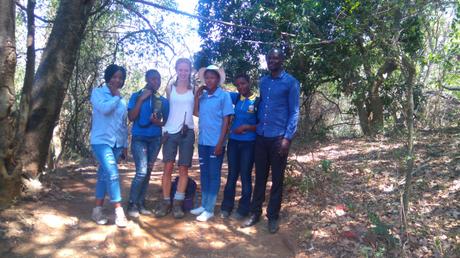Philip Faure, the Primate and Predator Project's Community Engagement Officer, held another Eco-Weekend for a local school this past weekend. We had the Wilmary Christian School from Kutama village up at Lajuma for two days, to teach them about various environmental topics. We had 13 learners and 3 teachers who were able to attend.
 The school group with Philip on the day of arrival.
The school group with Philip on the day of arrival.
On Friday the students and teachers arrived in the morning and we immediately started with presentations and activities. First on the agenda were the introductory presentation and a health and safety talks. We had our lunch and then straight after the group was split up into to two groups. One group went with two of the Primate Research Assistants, Alice and James, to follow the Samango monkeys. They were taught about the research that Andy and his team of assistants do, about data collection, and about general knowledge on primates. Alice and James certainly made for great educators and the students came back after half a day of field work with a lot of knowledge on Samango monkeys.
Natalie and Morgan, the PPP's two Predator Research Assistants, took the other half of the school group out on a camera run. They were taken on a very scenic route to go and change the batteries and SD cards from our cameras and bring the camera data back to the office. Natalie and Morgan taught them all about how the cameras are used in the Soutpansberg over a 60 km 2 grid, which monitor our leopard population abundance and the population trends. The students said they really enjoyed the hike. That evening, the students and Philip did all the cooking and spent some time making jokes and socialising around the fire. After dinner, Philip gave them a talk on primates of the Soutpansberg Mountain.

The following morning the two groups swapped activities and had a chance to learn the skills and knowledge that the other group did the previous day. They came back to the camp for lunch and afterwards were given a lecture on the different kinds of renewable energy sources used on Lajuma. They were taught how the solar energy and hydro-electricity generates power for the researchers and workers living on Lajuma. We discussed the advantages and disadvantages of these and some other sources of energy. When they were done with learning about energy, we moved on to a completely different topic, geographical information systems (GIS). As part of the grade 11 curriculum learners are taught about GIS in geography. Philip gave the learners a crash course on the basics of using the open-source software, QGIS, and how it can be applied in various sectors. The learners were quite captivated by QGIS and the headmaster asked Philip to come to their school to give a two day course on using QGIS.
